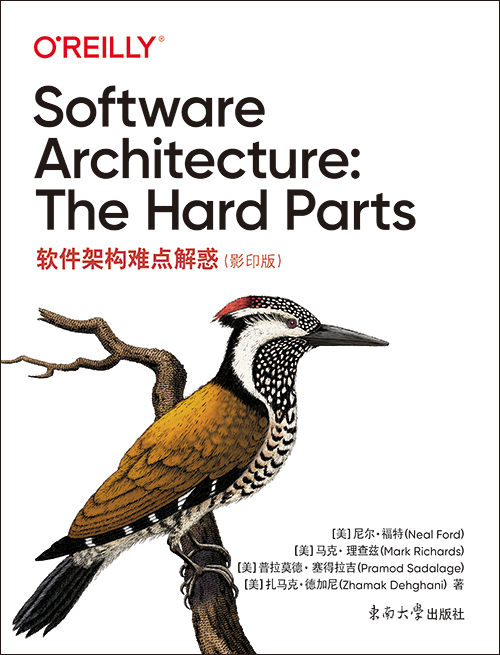软件架构难点解惑(影印版)
出版时间:2023年03月
页数:440
“本书是所有构建现代分布式系统的架构师的必读之作。”
——Aleksandar Serafimoski
Thoughtworks首席顾问
在软件架构中没有哪个决定是轻而易举的。相反,有许多艰难的部分,要么是难题,要么是缺少最佳实践,这迫使你在各种妥协中做出选择。通过本书,你将学会如何批判性地思考分布式架构的利弊。
软件架构老兵和实践顾问Neal Ford、Mark Richards、Pramod Sadalage、Zhamak Dehghani讨论了选择适合架构的策略。全书交织着一群虚构的技术专业人员(Sysops Squad)的故事,他们研究了从如何确定服务粒度、管理工作流和编排、管理和解耦契约、管理分布式事务到如何优化可扩展性、弹性和性能等操作特性的一切问题。
本书通过关注常见的问题,提供了一些技巧,帮助你在面对架构问题时进行权衡。
● 分析权衡并有效记录你的决策
● 作出更好的服务粒度决策
● 理解拆分单体应用的复杂性
● 管理和解耦服务之间的契约
● 在高度分布式架构中处理数据
● 学习在分解应用时的工作流和事务管理模式
——Aleksandar Serafimoski
Thoughtworks首席顾问
在软件架构中没有哪个决定是轻而易举的。相反,有许多艰难的部分,要么是难题,要么是缺少最佳实践,这迫使你在各种妥协中做出选择。通过本书,你将学会如何批判性地思考分布式架构的利弊。
软件架构老兵和实践顾问Neal Ford、Mark Richards、Pramod Sadalage、Zhamak Dehghani讨论了选择适合架构的策略。全书交织着一群虚构的技术专业人员(Sysops Squad)的故事,他们研究了从如何确定服务粒度、管理工作流和编排、管理和解耦契约、管理分布式事务到如何优化可扩展性、弹性和性能等操作特性的一切问题。
本书通过关注常见的问题,提供了一些技巧,帮助你在面对架构问题时进行权衡。
● 分析权衡并有效记录你的决策
● 作出更好的服务粒度决策
● 理解拆分单体应用的复杂性
● 管理和解耦服务之间的契约
● 在高度分布式架构中处理数据
● 学习在分解应用时的工作流和事务管理模式
- Preface
- 1. What Happens When There Are No “Best Practices”?
- Why “The Hard Parts”?
- Giving Timeless Advice About Software Architecture
- The Importance of Data in Architecture
- Architectural Decision Records
- Architecture Fitness Functions
- Architecture Versus Design: Keeping Definitions Simple
- Introducing the Sysops Squad Saga
- Part I. Pulling Things Apart
- 2. Discerning Coupling in Software Architecture
- Architecture (Quantum | Quanta)
- Sysops Squad Saga: Understanding Quanta
- 3. Architectural Modularity
- Modularity Drivers
- Sysops Squad Saga: Creating a Business Case
- 4. Architectural Decomposition
- Is the Codebase Decomposable?
- Component-Based Decomposition
- Tactical Forking
- Sysops Squad Saga: Choosing a Decomposition Approach
- 5. Component-Based Decomposition Patterns
- Identify and Size Components Pattern
- Gather Common Domain Components Pattern
- Flatten Components Pattern
- Determine Component Dependencies Pattern
- Create Component Domains Pattern
- Create Domain Services Pattern
- Summary
- 6. Pulling Apart Operational Data
- Data Decomposition Drivers
- Decomposing Monolithic Data
- Selecting a Database Type
- Sysops Squad Saga: Polyglot Databases
- 7. Service Granularity
- Granularity Disintegrators
- Granularity Integrators
- Finding the Right Balance
- Sysops Squad Saga: Ticket Assignment Granularity
- Sysops Squad Saga: Customer Registration Granularity
- Part II. Putting Things Back Together
- 8. Reuse Patterns
- Code Replication
- Shared Library
- Shared Service
- Sidecars and Service Mesh
- Sysops Squad Saga: Common Infrastructure Logic
- Code Reuse: When Does It Add Value?
- Sysops Squad Saga: Shared Domain Functionality
- 9. Data Ownership and Distributed Transactions
- Assigning Data Ownership
- Single Ownership Scenario
- Common Ownership Scenario
- Joint Ownership Scenario
- Service Consolidation Technique
- Data Ownership Summary
- Distributed Transactions
- Eventual Consistency Patterns
- Sysops Squad Saga: Data Ownership for Ticket Processing
- 10. Distributed Data Access
- Interservice Communication Pattern
- Column Schema Replication Pattern
- Replicated Caching Pattern
- Data Domain Pattern
- Sysops Squad Saga: Data Access for Ticket Assignment
- 11. Managing Distributed Workflows
- Orchestration Communication Style
- Choreography Communication Style
- Trade-Offs Between Orchestration and Choreography
- Sysops Squad Saga: Managing Workflows
- 12. Transactional Sagas
- Transactional Saga Patterns
- State Management and Eventual Consistency
- Techniques for Managing Sagas
- Sysops Squad Saga: Atomic Transactions and Compensating Updates
- 13. Contracts
- Strict Versus Loose Contracts
- Stamp Coupling
- Sysops Squad Saga: Managing Ticketing Contracts
- 14. Managing Analytical Data
- Previous Approaches
- The Data Mesh
- Sysops Squad Saga: Data Mesh
- 15. Build Your Own Trade-Off Analysis
- Finding Entangled Dimensions
- Trade-Off Techniques
- Sysops Squad Saga: Epilogue
- A. Concept and Term References
- B. Architecture Decision Record References
- C. Trade-Off References
- Index
书名:软件架构难点解惑(影印版)
国内出版社:东南大学出版社
出版时间:2023年03月
页数:440
书号:978-7-5766-0591-4
原版书书名:Software Architecture: The Hard Parts
原版书出版商:O'Reilly Media
The animal on the cover of Software Architecture: The Hard Parts is a black-rumped golden flameback woodpecker (Dinopium benghalense), a striking species of woodpecker found throughout the plains, foothills, forests, and urban areas of the Indian subcontinent.
This bird’s golden back is set atop a black shoulder and tail, the reason for its pyroinspired name. Adults have red crowns with black-and-white spotted heads and breasts, with a black stripe running from their eyes to the back of their heads. Like other common, small-billed woodpeckers, the black-rumped golden flameback has a straight pointed bill, a stiff tail to provide support against tree trunks, and four-toed feet—two toes pointing forward and two backward. As if its markings weren’t distinctive enough, the black-rumped golden flameback woodpecker is often detected by its call of “ki-ki-ki-ki-ki,” which steadily increases in pace.
This woodpecker feeds on insects, such as red ant and beetle larvae, underneath tree bark using its pointed bill and long tongue. They have been observed visiting termite mounds and even feeding on the nectar of flowers. The golden flameback also adapts well to urban habitats, subsisting on readily available fallen fruit and food scraps.
This bird’s golden back is set atop a black shoulder and tail, the reason for its pyroinspired name. Adults have red crowns with black-and-white spotted heads and breasts, with a black stripe running from their eyes to the back of their heads. Like other common, small-billed woodpeckers, the black-rumped golden flameback has a straight pointed bill, a stiff tail to provide support against tree trunks, and four-toed feet—two toes pointing forward and two backward. As if its markings weren’t distinctive enough, the black-rumped golden flameback woodpecker is often detected by its call of “ki-ki-ki-ki-ki,” which steadily increases in pace.
This woodpecker feeds on insects, such as red ant and beetle larvae, underneath tree bark using its pointed bill and long tongue. They have been observed visiting termite mounds and even feeding on the nectar of flowers. The golden flameback also adapts well to urban habitats, subsisting on readily available fallen fruit and food scraps.
购买选项
